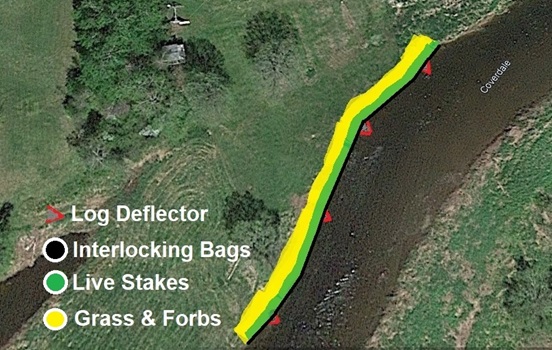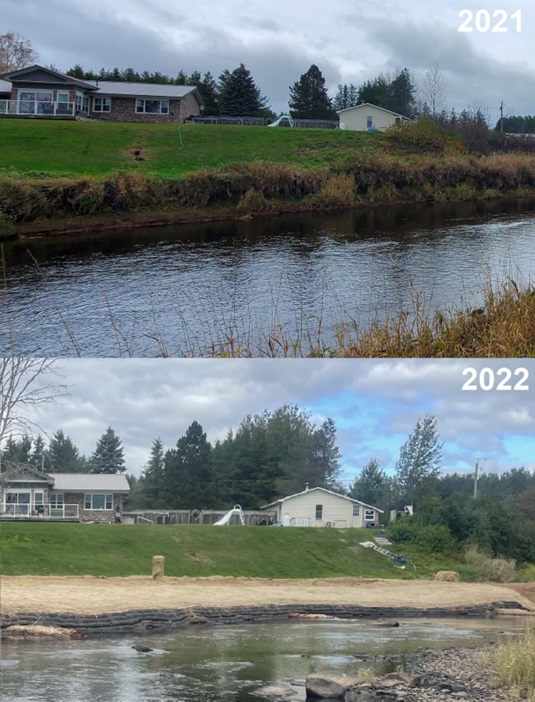Fourth Level Assessment – Aquatic Habitat Rehabilitation Plan
Bank Restoration
Little River, Synton 2022 (Fort Folly Habitat Recovery)
In 2019, the landowner of this site approached FFHR for help with his failing bank after he had visited the 2017 site below the first Rt. 895 bridge. Sites for such projects are prioritized through FFHR’s Stewardship planning process. Rapid Geomorphic Assessments on the Little River in 2019 classified 55% of the river as “In adjustment”, the most unstable ranking, including his section of bank (Figure 10). Salmon redds have been found in spawning gravel several hundred meters downstream of this site on multiple occasions in 2013, 2016, and 2020 (Figure 8). This is particularly noteworthy as logistical constraints limit adult releases to sites some distance away, so fish are clearly exploring the river and preferentially choosing to use this particular gravel. The concern is that silt being eroded from such a failing bank can pose a threat of suffocating salmon eggs within such redds.
In 2021 four PIT tagged salmon were detected returning to the Little River by an automated PIT tag reader antenna array FFHR operates located at the 895 bridge approximately 3 km downstream of this site. Three of these salmon were Little River origin fish, having been collected near that bridge in 2019 as smolts, raised to adulthood in Grand Manan by FSR and released on the Pollett River (where all FSR fish are released) in the fall of 2020. Yet in 2021, these Little River salmon returned preferentially to their natal river. Given a motivated landowner, a threat to high quality habitat, and evidence of salmon accessing that habitat under their own power, this site was prioritized in 2021, for work in 2022.
Instead of employing a rock toe as had been done in 2017 at the site below the first Rt. 895 bridge, this project in 2022 used four log deflectors installed at key points along the toe of the bank (Figure 26) to re-establish the radius of curvature through this portion of the river. These log deflectors were built out of pairs of 10 m long hemlock logs (90% of each of which was embedded back into the final bank). The bank was reconstructed with a system of interlocked Flex MSE bags (Trexiana Wholesale and Distribution LTD, Surrey, BC) filled with a mixture of clay, sand, pebbles, seed and organics, stacked to the desired height and stepped back to achieve the required slope (cover, top photo). The lower levels of bags were wrapped with plastic geogrid that was anchored deep into the bank to provide additional support. Similarly, the upper levels were wrapped in jute. The bank above the bags was seeded with grass and forbs and the 140 m2 of reconstructed bank was planted with 620 live stakes to a density of 4.4 stems per m2 (Figure 27). These were a mix of several species of willow (460 live stakes) and red-osier dogwood (160 live stakes). The grass and forbs germinated quickly and will immediately help stabilize the site over the winter. In the spring of 2023 the live stakes will root out, and as these grow this woody vegetation will bind together the newly rebuilt bank reinforcing it further, becoming progressively stronger as these get bigger and once well established will provide opportunities for recruitment of additional vegetation.


Figure 28 is the beginning of a repeat photography time series of photos of the site taken before work was done there in 2021 and again afterwards in 2022. Post construction, cross sections were surveyed across the length of the site to record the new bank slope so that in the future comparisons can be made to document and quantify the extent to which stability has been achieved and maintained

As with FFHR’s other sites, additional long-term monitoring at this site required collection of 2022 pre-construction baselines includes electrofishing to assess how fish are responding to the work done, and Canadian Aquatic Biomonitoring Network (CABIN) wadeable streams monitoring (CABIN 2012). It is noteworthy that the electrofishing survey detected salmon fry (Figure 8) in 2022 just below the site. Given that no fry or adults were released nearby, this provides confirmation that salmon (possibly the Little River origin returns detected by the array downstream in 2021) successfully spawned in the area during the previous fall.













